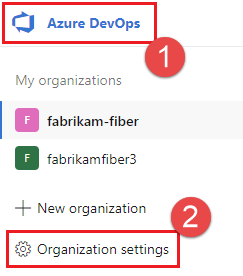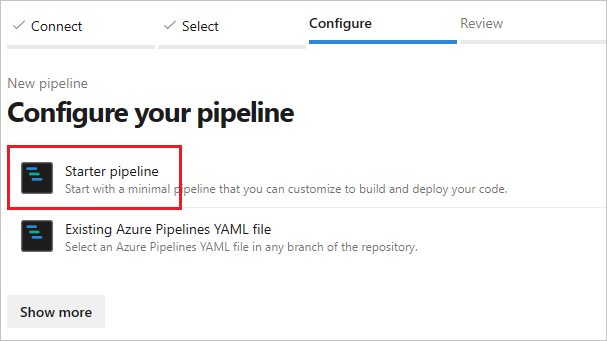Quickstart: Create a Managed DevOps Pool using Azure CLI
This article shows you how to create a Managed DevOps Pool using Azure CLI, and run a pipeline in it.
Prerequisites
Before completing the steps in this article, you must have configured your Azure subscription and Azure DevOps organization for use with Managed DevOps Pools, as described in the Prerequisites article. These steps need to be completed only once per Azure subscription and Azure DevOps organization.
Install or run in Azure Cloud Shell
The easiest way to learn how to use the Azure CLI is by running a Bash environment in Azure Cloud Shell through your browser. To learn about Cloud Shell, see Quickstart for Bash in Azure Cloud Shell.
When you're ready to install the Azure CLI, see the installation instructions for Windows, Linux, macOS, and Docker container.
Check your version by running az --version. Azure Cloud Shell always has the latest version of the Azure CLI preinstalled.
az version
Sign in to the Azure CLI
Open a command prompt (on Windows, use Windows Command Prompt or PowerShell) and run the following commands. If you're using Azure Cloud Shell you don't need to run az login unless you want to use a different account.
Sign in the to Azure CLI.
az loginIf you have more than one Azure subscription, set your default Azure subscription.
az account set --subscription "My subscription name"To get a list of your subscriptions, you can run the following command.
az account list -o tableIf you have multiple tenants, or want to see more information about working with Azure subscription using Azure CLI, see How to manage Azure subscriptions with the Azure CLI.
Define environment variables
Run the following commands to generate the names for the resources in this quickstart. This example uses the
EastUS2region. ReplaceEastUS2with your desired region.export RANDOM_ID="$(openssl rand -hex 3)" export RESOURCE_GROUP_NAME="myManagedDevOpsPoolGroup$RANDOM_ID" export REGION=EastUS2 export POOL_NAME="mdpPool$RANDOM_ID" export DEV_CENTER_NAME="mdpDevCenter$RANDOM_ID" export DEV_CENTER_PROJECT_NAME="mdpDevCenterProject$RANDOM_ID"Run the following commands to review your resource names.
echo $RESOURCE_GROUP_NAME echo $POOL_NAME echo $DEV_CENTER_NAME echo $DEV_CENTER_PROJECT_NAME echo $REGION
Create a resource group
Run the following command to create the resource group to contain the resources used in this quickstart.
az group create --name $RESOURCE_GROUP_NAME --location $REGION
Create a dev center and dev center project
Install the Azure CLI
devcenterextension, and ensure it is upgraded to the latest version if it is already installed.az extension add --name devcenter --upgradeRun the following commands to create a dev center and dev center project.
# Create a dev center az devcenter admin devcenter create -n $DEV_CENTER_NAME \ -g $RESOURCE_GROUP_NAME \ -l $REGION # Save the id of the newly created dev center DEVCID= \ $(az devcenter admin devcenter show -n $DEV_CENTER_NAME \ -g $RESOURCE_GROUP_NAME \ --query id -o tsv) # Create a dev center project az devcenter admin project create -n $DEV_CENTER_PROJECT_NAME \ --description "My dev center project." \ -g $RESOURCE_GROUP_NAME \ -l $REGION \ --dev-center-id $DEVCID # Save the dev center project for use when creating # the Managed DevOps Pool DEVCPID= \ $(az devcenter admin project show -n $DEV_CENTER_PROJECT_NAME \ -g $RESOURCE_GROUP_NAME \ --query id -o tsv)After a few moments, the output indicates that the Dev center was created. The
idof the created dev center is saved inDEVCIDand is used to create the dev center project.{ "devCenterUri": "https://...", "id": "/subscriptions/aaaa0a0a-bb1b-cc2c-dd3d-eeeeee4e4e4e/resourceGroups/resourceGroupName/providers/Microsoft.DevCenter/devcenters/devCenterName", "location": "eastus", "name": "devCenterName", "provisioningState": "Succeeded", "resourceGroup": "resourceGroupName", "systemData": { ... }, "type": "microsoft.devcenter/devcenters" }After a few more moments, the output indicates that the dev center project was created. The
idof the created dev center project is saved inDEVCPIDand is used when creating the Managed DevOps Pool in the next section.{ "description": "My dev center project.", "devCenterId": "...", "devCenterUri": "https://...", "id": "/subscriptions/aaaa0a0a-bb1b-cc2c-dd3d-eeeeee4e4e4e/resourceGroups/resourceGroupName/providers/Microsoft.DevCenter/projects/devCenterProjectName", "location": "eastus", "name": "devCenterProjectName", "provisioningState": "Succeeded", "resourceGroup": "resourceGroupName", "systemData": { ... }, "type": "microsoft.devcenter/projects" }
Prepare the Managed DevOps Pool configuration files
The mdp pool create method has several parameters that take JSON values that configure different aspects of the pool.
agent-profilespecifies whether the pool is stateful or stateless, and contains the standby agent schedule. It is a dictionary with a single key named eitherStatefulorStateless, depending on your desired agent configuration. For more information onagent-profileproperties, see Configure scaling.fabric-profilespecifies the agent size, VM images, OS disk, and attached storage. For more information on thefabric-profileproperties, see Configure pool settings and Configure additional storage.organization-profilespecifies the Azure DevOps organizations and projects that can use the pool. For more information onorganization-profilesettings, see Configure security settings - Configure organization access.
Create the following three files and save them to the folder where you plan to run the Azure CLI commands to create the pool.
Create a file name agent-profile.json with the following contents.
{ "Stateless": {} }This configuration specifies a stateless agent for your pool.
Create a file named fabric-profile.json with the following contents.
{ "vmss": { "sku": { "name": "Standard_D2as_v5" }, "images": [ { "aliases": [ "ubuntu-22.04" ], "buffer": "*", "wellKnownImageName": "ubuntu-22.04/latest" } ], "osProfile": { "secretsManagementSettings": { "observedCertificates": [], "keyExportable": false }, "logonType": "Service" }, "storageProfile": { "osDiskStorageAccountType": "Standard", "dataDisks": [] } } }This configuration specifies a pool using the Standard_D2as_v5 image, the ubuntu-22.04 Azure Pipelines image, and a Standard OS Disk type with no attached data disk.
Create a file named organization-profile.json with the following contents. Replace
<organization-name>with the name for your Azure DevOps organization.{ "azure-dev-ops": { "organizations": [ { "url": "https://dev.azure.com/<organization-name>", "projects": [], "parallelism": 1 } ], "permissionProfile": { "kind": "CreatorOnly" } } }This configuration specifies a pool that is available to all projects in your Azure DevOps organization.
Create the Managed DevOps Pool
Install the
mdpextension, and ensure it is upgraded to the latest version if it is already installed.az extension add --name mdp --upgradeCreate the Managed DevOps Pool by running the following az mdp pool create command.
az mdp pool create -n $POOL_NAME \ -g $RESOURCE_GROUP_NAME \ -l $REGION \ --devcenter-project-id $DEVCPID \ --maximum-concurrency 1 \ --agent-profile agent-profile.json \ --fabric-profile fabric-profile.json \ --organization-profile organization-profile.jsonIf your subscription doesn't have the capacity to configure your pool with desired Azure VM SKU and maximum agents count, pool creation fails with an error similar to the following message.
Cores needed to complete this request is 2, which exceeds the current limit of 0 for SKU family standardDDSv4Family in region eastus. Please choose a different region if possible, or request additional quota at https://portal.azure.com/#view/Microsoft_Azure_Support/NewSupportRequestV3Blade/issueType/quota/subscriptionId/subscription_id_placeholder/topicId/3eadc5d3-b59a-3658-d8c6-9c729ba35b97. To resolve the issue, see Review Managed DevOps Pools quotas.
View your created pool in the Azure portal
Sign in to the Azure portal.
Search for Managed DevOps Pools and select it from the available options.
Choose your new Managed DevOps Pool from the list.
Choose JSON View to see the JSON format of your Managed DevOps Pools resource.

View the agent pool in Azure DevOps
Go to the Azure DevOps portal and sign in to your Azure DevOps organization (
https://dev.azure.com/{your-organization}).Go to Azure DevOps > Organization settings.

Go to Pipelines > Agent pools, and verify that your new pool is listed. If you just created the Managed DevOps Pool, it can take a few moments for the new pool to appear in the agents list.

Run a pipeline in your new pool
In this step, we'll create a simple pipeline in the default repository of an Azure DevOps project and run it in your new Managed DevOps Pool.
Go to the Azure DevOps portal and sign in to your Azure DevOps organization (
https://dev.azure.com/{your-organization}).Go to the project where you want to run the pipeline, and choose Pipelines.

Choose New pipeline (or Create Pipeline if this is your first pipeline).

Choose Azure Repos Git.

Choose the repository that has the same name as your project. In this example, the project is named FabrikamFiber, so we choose the repository with the same name.

Choose Starter pipeline.

By default the starter template uses a Microsoft hosted Linux agent. Edit the pipeline template and change the
poolsection so that it refers to the pool you created in the previous steps.# Change these two lines as shown in the following example. pool: vmImage: ubuntu-latestIn this example, the Managed DevOps Pools is named
fabrikam-managed-pool, so replacevmImage: ubuntu-latestwithname: fabrikam-managed-pools, and specify the name of your Managed DevOps Pool.# Replace fabrikam-managed-pools with the name # of your Managed DevOps Pool. pool: name: fabrikam-managed-poolChoose Save and run, and choose Save and run a second time to confirm.

If this is the first pipeline run in this pool, you may be asked to grant permissions before the pipeline runs.
Watch the pipeline run in Azure DevOps, and you can switch over to the Azure portal and see the running agent in the Agents view.
Clean up resources
If you're not going to continue to use this application, delete the resource group, dev center, dev center project, and the Managed DevOps Pool. This quickstart created all of the resources in a new resource group, so you can delete them all by using the az group delete command to delete the resource group and all of its resources.
az group delete -n $RESOURCE_GROUP_NAME